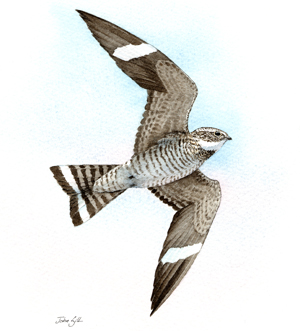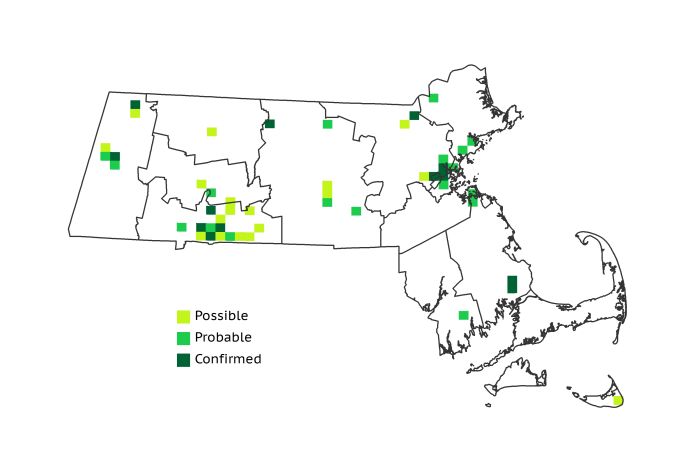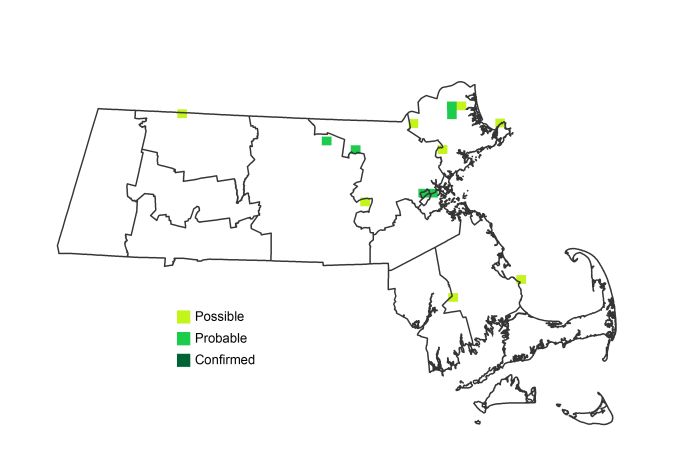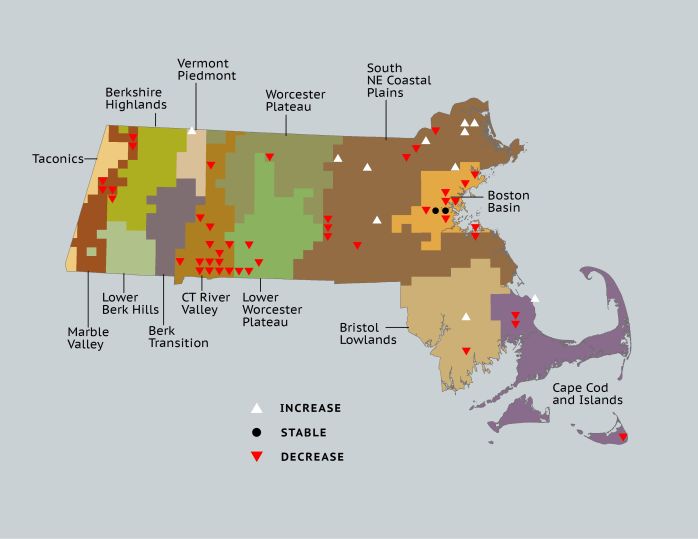Breeding Bird Atlases (BBA)
Find a Bird
Common Nighthawk
Chordeiles minor

Very local and strongly declining
Conservation action urgent

“It was the most wild and desolate region we had camped in, where, if anywhere, one might expect to meet with befitting inhabitants, but I heard only the squeak of a nighthawk flitting over.” – Henry David Thoreau, The Maine Woods
Nighthawks belong to the family Caprimulgidae, colloquially known as “nightjars” or “goatsuckers.” The latter name comes from the erroneous belief that these birds sucked the milk from lactating goats. Actually, Common Nighthawks subsist almost entirely on flying insects, which their sharp eyes and swift wings make them well adapted to pursue from sunset to sunrise. At one time this species was a successful urban nester, which raises the question of why it seems to be disappearing from Massachusetts.
Historic Status
One of the favorite sightings of Massachusetts birders, the Common Nighthawk is unfortunately no longer as prevalent as it once was in the Commonwealth. Historically primarily ground nesters, nighthawks thrived in Massachusetts during the farming era. As early as the 1860s (Forbush 1908) they could be found nesting on gravel roofs in cities, areas that provided ample supplies of aerial insects for early-evening capture on the wing. Generations of Boston Red Sox fans have no doubt seen Common Nighthawks flying over Fenway Park during night games, whether they realized it or not. The aggregation of flying insects attracted to the bright stadium lights provided an irresistible lure for hungry nighthawks.
Atlas 1 Distribution
As the state’s landscape began to shift from fields and hedgerows to suburbs and mature woods, Common Nighthawks began to respond to the pressure. Atlas 1 surveys found a scattering of nighthawks all over the state, particularly in the Marble Valleys, the Lower Worcester Plateau, the Coastal Plains, and to a lesser extent the Cape and Islands. The only strongholds of the species during the late 1970s were the Boston Basin and the Connecticut River Valley, which together accounted for almost half of all occupied nighthawk blocks in Atlas 1. The Boston and Springfield metropolitan areas in particular had large concentrations of breeding nighthawks because a plethora of electric lights attracted an abundance of aerial prey and gravel rooftops offered suitable opportunities for nesting.
Atlas 2 Distribution and Change
Despite all of these historic clues, Atlas workers conducting the fieldwork for Atlas 2 came home nearly empty-handed when it came to Common Nighthawks. While a handful of reports affirmed the bird’s presence in the state during the breeding season, not a single nesting Confirmation was submitted. In fact, the species’ footprint declined 70% between the Atlases, making them one of the most steeply declining birds in the Commonwealth. This trend is followed by many other aerial-hunting insectivores.
Atlas 1 Map

Atlas 2 Map

Atlas Change Map

Ecoregion Data
Atlas 1 | Atlas 2 | Change | ||||||
Ecoregion | # Blocks | % Blocks | % of Range | # Blocks | % Blocks | % of Range | Change in # Blocks | Change in % Blocks |
Taconic Mountains | 0 | 0.0 | 0.0 | 0 | 0.0 | 0.0 | 0 | 0.0 |
Marble Valleys/Housatonic Valley | 5 | 12.8 | 10.2 | 0 | 0.0 | 0.0 | -5 | -12.8 |
Berkshire Highlands | 1 | 1.8 | 2.0 | 0 | 0.0 | 0.0 | -1 | -1.9 |
Lower Berkshire Hills | 0 | 0.0 | 0.0 | 0 | 0.0 | 0.0 | 0 | 0.0 |
Vermont Piedmont | 0 | 0.0 | 0.0 | 1 | 5.9 | 7.1 | 1 | 8.3 |
Berkshire Transition | 0 | 0.0 | 0.0 | 0 | 0.0 | 0.0 | 0 | 0.0 |
Connecticut River Valley | 14 | 25.0 | 28.6 | 0 | 0.0 | 0.0 | -14 | -29.2 |
Worcester Plateau | 2 | 2.6 | 4.1 | 0 | 0.0 | 0.0 | -1 | -2.1 |
Lower Worcester Plateau | 5 | 6.8 | 10.2 | 0 | 0.0 | 0.0 | -4 | -7.4 |
S. New England Coastal Plains and Hills | 8 | 3.0 | 16.3 | 9 | 3.2 | 64.3 | 0 | 0.0 |
Boston Basin | 10 | 17.9 | 20.4 | 2 | 3.6 | 14.3 | -8 | -14.5 |
Bristol and Narragansett Lowlands | 1 | 0.9 | 2.0 | 1 | 0.9 | 7.1 | 0 | 0.0 |
Cape Cod and Islands | 3 | 2.2 | 6.1 | 1 | 0.7 | 7.1 | -2 | -1.7 |
Statewide Total | 49 | 5.1 | 100.0 | 14 | 1.4 | 100.0 | -34 | -4.1 |
Notes
With habitat changes taking place that no longer favored Common Nighthawks–including the substitution of rubberized roofing material these days in place of old-fashioned gravel roof surfaces – the future of the Common Nighthawk in Massachusetts looked pretty grim at the end of Atlas 2. Even so, all hope may not yet be lost – one Confirmed report of a Common Nighthawk nest in Brookline, Massachusetts, was submitted the year after formal data collection had ended.



